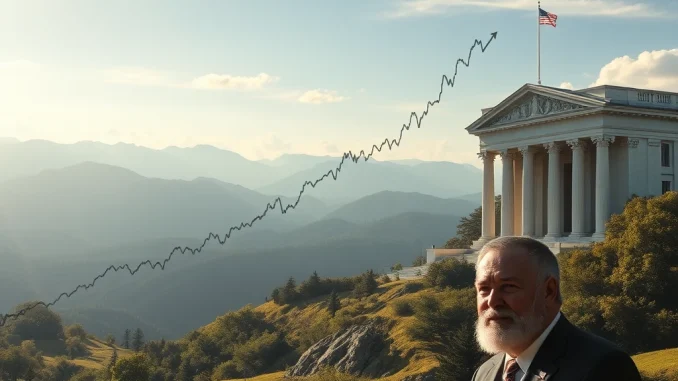
Imagine Bitcoin hitting a staggering $1 million. While it sounds like a distant dream to some, prominent figures in the crypto space are making bold predictions. Arthur Hayes, co-founder of the BitMEX cryptocurrency exchange, is one such voice, laying out a compelling case for why he believes the world’s leading digital asset could reach this monumental figure by 2028. This isn’t just a hopeful guess; his argument is rooted in significant macroeconomic shifts he anticipates, particularly concerning U.S. Federal Reserve policy and the flow of capital.
Arthur Hayes’ Bold Bitcoin Price Prediction
In a recent discussion on the David Lin Report, Arthur Hayes didn’t hold back. He presented a detailed outlook suggesting a massive surge for Bitcoin (BTC) over the coming years. His immediate prediction is noteworthy: a rise to $250,000 by the close of the current year. But the long-term forecast is what truly captures attention: a potential climb to a remarkable $1 million by 2028. This ambitious target is tied directly to his analysis of future economic policies and their likely impact on financial markets.
Hayes’ prediction isn’t pulled from thin air. It’s based on a specific macroeconomic thesis centered around liquidity injections into the U.S. economy. He projects that the U.S. Federal Reserve will inject approximately $9 trillion in liquidity by 2028. This enormous sum of money, he argues, will significantly influence asset prices.
Understanding the Fed Liquidity Factor
The core of Arthur Hayes’ argument rests on the concept of liquidity expansion by the Federal Reserve. When the Fed injects liquidity, it essentially increases the money supply available in the financial system. This can happen through various mechanisms, such as quantitative easing (QE) or adjustments to reserve requirements for banks.
Hayes contends that this projected $9 trillion influx will initially bolster traditional economic sectors. Think manufacturing, infrastructure, and other real economy areas. This is because increased liquidity makes borrowing cheaper and more accessible for businesses. However, he stresses that this capital doesn’t stay contained within traditional spheres. A significant portion is expected to spill over into risk assets.
What are risk assets? They include things like stocks, commodities, and, crucially for this discussion, cryptocurrencies like Bitcoin. When there’s ample liquidity and low interest rates, investors tend to seek higher returns in assets that carry more risk but offer greater potential upside compared to safer investments like government bonds.
How Bank Regulations Could Impact the BTC Forecast
Another key piece of Hayes’ analysis involves changes in banking regulations. He specifically pointed to the easing of capital requirements for banks holding U.S. Treasuries. This regulatory shift has a direct impact on banks’ lending capacity. By requiring less capital to back their Treasury holdings, banks have more flexibility to extend credit.
This freed-up capacity is significant. It means banks can potentially lend more money to businesses and individuals. This credit expansion further fuels economic activity and increases the overall money supply circulating in the economy. Hayes believes this increased lending capacity, coupled with the direct liquidity injections, creates a powerful tailwind for asset markets.
The flow is envisioned as follows:
- Fed injects liquidity and eases bank requirements.
- Banks expand credit to the real economy (e.g., manufacturing).
- Excess liquidity and credit flow into financial markets.
- Risk assets, including Bitcoin, benefit from increased capital seeking returns.
This cascading effect is central to why Hayes sees such a strong potential for Bitcoin’s price to escalate dramatically.
Is a $1M Bitcoin Price Realistic? Examining the BTC Forecast
A $1 million Bitcoin price tag is a substantial leap from current levels, even considering Hayes’ immediate $250,000 target for this year. While the macroeconomic drivers he outlines provide a potential framework, achieving such a valuation depends on numerous factors aligning:
- **Continued Adoption:** For Bitcoin’s market cap to grow to support a $1M price per coin (which would be trillions of dollars), its adoption as a store of value, medium of exchange, or institutional asset needs to expand significantly globally.
- **Inflation and Currency Debasement:** If the liquidity injections lead to significant inflation, the purchasing power of fiat currencies decreases, potentially making scarce assets like Bitcoin more attractive as a hedge.
- **Regulatory Environment:** Future regulations around cryptocurrencies could either hinder or accelerate adoption and price appreciation.
- **Technological Development:** Scalability solutions and other technological advancements could improve Bitcoin’s usability and appeal.
- **Market Cycles:** Bitcoin is known for its volatility and distinct bull/bear cycles, often influenced by events like the halving. While macro factors are important, these internal market dynamics also play a role.
Hayes’ forecast is based on a specific interpretation of future monetary policy. Other economists and analysts may have different projections for Fed actions or their impact on markets. It’s important for investors to consider a range of perspectives.
Putting Arthur Hayes’ Forecast in Context
Arthur Hayes is a well-known, and often controversial, figure in the crypto space. As the co-founder of BitMEX, he was at the forefront of the industry during a period of rapid growth. He is also known for his insightful, albeit sometimes provocative, commentary on global macroeconomics and their relationship to cryptocurrencies, particularly Bitcoin. His blog, ‘MacroTourist’, is widely read for its unique perspective on financial markets.
While his predictions are bold, they are typically grounded in a detailed analysis of global financial systems and central bank actions. He has correctly identified key macroeconomic trends in the past, adding weight to his current outlook, though no forecast is guaranteed.
Key Takeaways and Actionable Insights
Arthur Hayes’ forecast highlights the potential impact of macroeconomic factors on the crypto market. Here are some key points to consider:
- **Macro Matters:** Global liquidity, interest rates, and central bank policies are not isolated from the crypto market. They can significantly influence capital flows into assets like Bitcoin.
- **Liquidity is a Driver:** Increased liquidity in the traditional financial system often seeks higher returns in riskier assets, benefiting crypto.
- **Long-Term Perspective:** Hayes’ $1M prediction is a long-term target (2028), suggesting that significant price appreciation may take time and unfold over several years.
- **Volatility Remains:** Even with potential long-term upside, the path to higher prices for Bitcoin is likely to involve significant volatility.
- **Stay Informed:** Understanding macroeconomic trends can provide valuable context for navigating the cryptocurrency market.
This isn’t financial advice, but rather an exploration of a prominent figure’s market outlook. Investors should conduct their own research and consider their own risk tolerance.
Conclusion
Arthur Hayes’ prediction of Bitcoin reaching $1 million by 2028, fueled by a projected $9 trillion in Fed liquidity, is undoubtedly a headline-grabbing forecast. His thesis, linking macroeconomic policy shifts to the potential flow of massive capital into risk assets like BTC, provides a compelling narrative for long-term bullishness. While achieving such a target faces potential hurdles and depends on a confluence of factors, Hayes’ analysis serves as a powerful reminder of how interconnected the traditional financial world and the burgeoning crypto market are. Whether Bitcoin hits $1 million by 2028 or not, the macroeconomic forces he discusses will likely play a significant role in shaping its future price trajectory.



